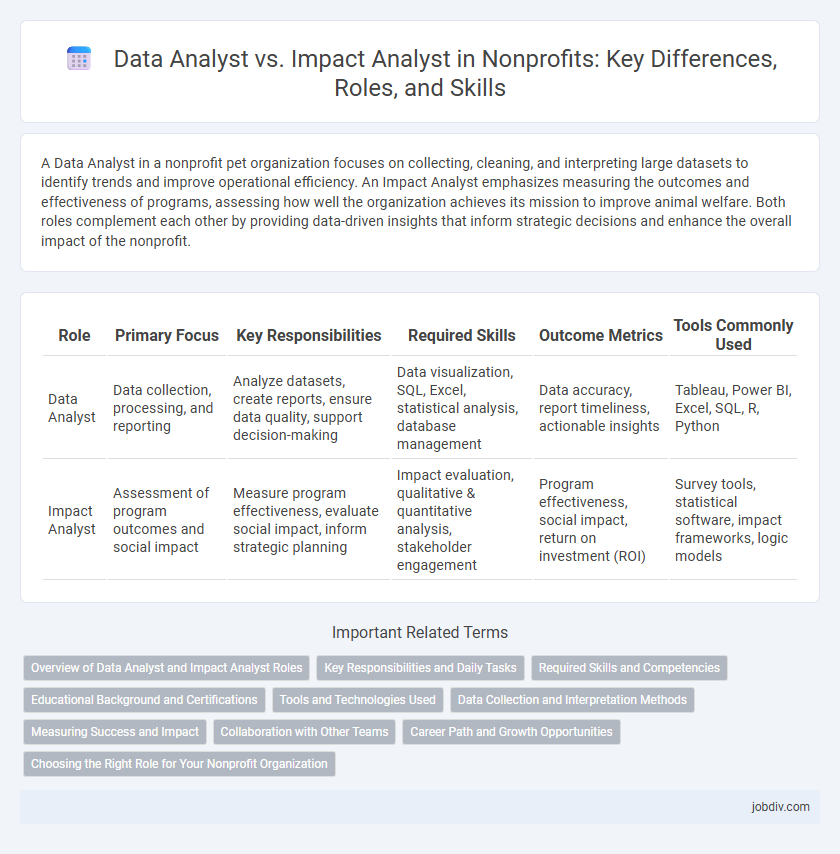A Data Analyst in a nonprofit pet organization focuses on collecting, cleaning, and interpreting large datasets to identify trends and improve operational efficiency. An Impact Analyst emphasizes measuring the outcomes and effectiveness of programs, assessing how well the organization achieves its mission to improve animal welfare. Both roles complement each other by providing data-driven insights that inform strategic decisions and enhance the overall impact of the nonprofit.
Table of Comparison
| Role | Primary Focus | Key Responsibilities | Required Skills | Outcome Metrics | Tools Commonly Used |
|---|---|---|---|---|---|
| Data Analyst | Data collection, processing, and reporting | Analyze datasets, create reports, ensure data quality, support decision-making | Data visualization, SQL, Excel, statistical analysis, database management | Data accuracy, report timeliness, actionable insights | Tableau, Power BI, Excel, SQL, R, Python |
| Impact Analyst | Assessment of program outcomes and social impact | Measure program effectiveness, evaluate social impact, inform strategic planning | Impact evaluation, qualitative & quantitative analysis, stakeholder engagement | Program effectiveness, social impact, return on investment (ROI) | Survey tools, statistical software, impact frameworks, logic models |
Overview of Data Analyst and Impact Analyst Roles
Data Analysts in nonprofits focus on collecting, processing, and interpreting quantitative data to improve program efficiency and decision-making. Impact Analysts evaluate the effectiveness and social outcomes of nonprofit initiatives by analyzing qualitative and quantitative impact metrics. Both roles use data-driven insights to support organizational goals but differ in emphasis on operational performance versus mission-driven impact measurement.
Key Responsibilities and Daily Tasks
Data Analysts in nonprofits focus on collecting, organizing, and interpreting quantitative data to support decision-making and reporting, using tools like Excel, SQL, and data visualization software. Impact Analysts evaluate program effectiveness by measuring social outcomes and conducting qualitative and quantitative assessments to demonstrate the organization's influence on target communities. Both roles involve collaborating with stakeholders to ensure data accuracy and drive strategic improvements, but Data Analysts emphasize data management while Impact Analysts prioritize analyzing program success and social impact.
Required Skills and Competencies
Data Analysts in nonprofits prioritize proficiency in data visualization tools, statistical software like R or Python, and strong quantitative analysis skills to interpret large datasets effectively. Impact Analysts require expertise in program evaluation, outcome measurement, and qualitative research methods to assess the real-world changes driven by nonprofit initiatives. Both roles demand critical thinking, attention to detail, and the ability to communicate complex findings clearly to diverse stakeholders.
Educational Background and Certifications
Data Analysts in nonprofits typically have degrees in statistics, computer science, or data science, often supplemented by certifications such as Microsoft Certified: Data Analyst Associate or Google Data Analytics Professional Certificate. Impact Analysts usually hold backgrounds in social sciences, public policy, or education and pursue certifications like the Certified Nonprofit Professional (CNP) or specialized courses in program evaluation and impact measurement. Both roles benefit from knowledge in data visualization tools and statistical software, but Impact Analysts focus more on qualitative methods and outcomes-based assessment credentials.
Tools and Technologies Used
Data analysts in nonprofits primarily rely on tools like SQL, Excel, and Tableau to process and visualize large datasets, enhancing operational efficiency and decision-making. Impact analysts often use specialized software such as R, Python, and tools like Social Value International's Impact Framework for evaluating program effectiveness and social outcomes. Both roles integrate data management platforms and CRM software like Salesforce to ensure accurate data collection and reporting tailored to nonprofit goals.
Data Collection and Interpretation Methods
Data Analysts in nonprofits primarily utilize quantitative data collection methods such as surveys, databases, and statistical software to process large datasets for trend identification and decision-making. Impact Analysts focus on both qualitative and quantitative data, employing mixed methods like interviews, case studies, and outcome mapping to interpret program effectiveness and social change. The combination of statistical analysis and narrative evaluation ensures comprehensive insights into nonprofit performance and community impact.
Measuring Success and Impact
Data Analysts in nonprofits primarily focus on collecting, cleaning, and interpreting quantitative data to measure program efficiency and resource allocation. Impact Analysts emphasize qualitative and quantitative metrics to evaluate the broader social and community outcomes, ensuring alignment with organizational mission and long-term goals. Both roles contribute to strategic decision-making by providing insights into success indicators and impact measurement frameworks essential for donor reporting and program improvement.
Collaboration with Other Teams
Data Analysts in nonprofits focus on processing and interpreting quantitative data to support decision-making, collaborating closely with IT and program teams to ensure data accuracy and accessibility. Impact Analysts work alongside fundraising, communications, and program staff to evaluate the effectiveness of initiatives, translating qualitative and quantitative findings into actionable insights that demonstrate social impact. Both roles require strong cross-functional teamwork to align data-driven strategies with organizational goals and stakeholder expectations.
Career Path and Growth Opportunities
Data analysts in nonprofits specialize in collecting and interpreting quantitative data to optimize operational efficiency and program delivery, with career paths often advancing into data science or business intelligence roles. Impact analysts focus on evaluating the effectiveness of programs and measuring social outcomes, offering growth opportunities into strategic planning, grant management, or executive leadership positions. Both roles demand strong analytical skills but diverge in focus, with data analysts emphasizing technical data manipulation and impact analysts concentrating on storytelling through metrics for stakeholder engagement.
Choosing the Right Role for Your Nonprofit Organization
Selecting between a Data Analyst and an Impact Analyst for your nonprofit hinges on your organization's goals; Data Analysts excel in managing and interpreting large datasets to optimize operational efficiency, while Impact Analysts specialize in evaluating program effectiveness and measuring social outcomes. Nonprofits aiming to improve internal processes and data-driven decision-making benefit from a Data Analyst, whereas those focused on demonstrating tangible community impact and reporting to stakeholders require an Impact Analyst. Assessing your nonprofit's immediate priorities and long-term mission alignment guides the strategic choice, ensuring the right expertise drives meaningful growth and accountability.
Data Analyst vs Impact Analyst Infographic

 jobdiv.com
jobdiv.com